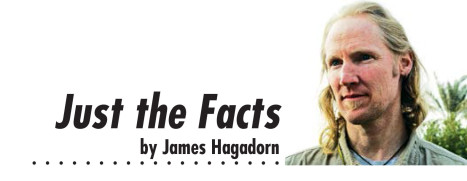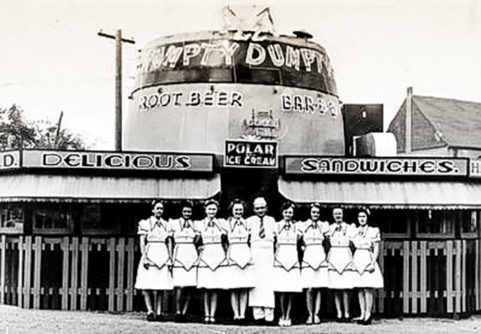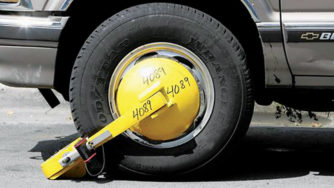
In the spirit of fake news and urban legends, Colorado is well known for inventing the teddy bear. And the cheeseburger. Not to mention outdoor Christmas lights, juvenile detention centers, and the shopping mall. And every ski bum’s favorite was born here too—the ticket wicket. You know, that wire you hang your lift ticket on.
Despite common knowledge, none of these were actually invented here. All have well-documented histories, long before their appearance in Colorado.
Yet Colorado is a hotbed of bona fide invention, with plenty of gadgets and processes borne out of ingenuity, engineering and sometimes a bit of luck.
For example, Wheat Ridge’s Bill and Dorothy Harmsen had bad luck selling ice cream in the 1940s. But their luck turned good in 1949 when they created everyone’s favorite middle-school treat–Jolly Ranchers.

Cheeseburgers: first patented by L. Ballast of Denver’s Humpty Dumpty Drive-In.
One of the most iconic elements of cowboy style was invented in Denver, when in 1946 Jack Weil added snaps to a western shirt. These mother-of-pearl-covered diamond-shaped snaps provided the wearer with a bit of bling as well as utility. That’s because the snaps permitted the shirts to behave like tear-away warmup pants do in basketball, but for a cowboy who’d snagged their shirt while on horseback.
One of the most unsung inventions came from the Gates Rubber Company of Denver, which in 1917 invented giant rubber-band-like belts called “V-belts.” Even today, these somewhat stretchable V-belts connect pulleys and other moving parts in nearly every car, motorcycle and boat engine, not to mention most industrial motors.
The term xeriscape and the tenets of xeriscaping, now used throughout the West to help conserve water, was borne after the 1977 drought that parched the American West. Seeking to help customers stretch their resources by promoting water-thrifty landscaping, Nancy Leavitt of Denver Water coined the term xeriscape in 1981. They even unveiled the first demonstration xeriscape garden in an “X-rated” party in 1982, playing off their newly minted x-word.
Sometimes determining when and where something is invented is a fuzzy business.
For example, is it when the idea is conceived, when it’s put into practice, or when it’s patented? Witness poor Henry Perky of Denver, who was bedraggled by chronic abdominal pain and ulcers. Facing a lifetime in which his diet would be dominated by boiled whole wheat grain, when visiting Nebraska he came up with a better idea than settling for such tasteless bowel-calming blah. He invented a new way to boil wheat, shred it, bake it, and reconstitute it into tiny pillows of roughage. After proofing the concept in New Jersey and then presenting the concept at the World’s Fair in Chicago, he started distributing these biscuits in downtown Denver. Such shredded wheat was a hit, and has been a mainstay of fiber fanatics ever since. But where was it actually invented? Nebraska, New Jersey or Colorado? Ditto for the cheeseburger, which was first patented in 1935 by Louis Ballast of Denver’s Humpty Dumpty Drive-In. Yet cheeseburgers appeared on menus in California over a decade prior.
Several well-known Colorado “inventions” were really just adaptations of pre-existing creations, resulting in products that are both loved and loathed. Such as Crocs. In about 2001, its founders decided to add a heel to existing foam clogs made by another manufacturer, and of course gave them a much cooler name. The rest is history. Or the “Denver Boot” of 1944, which was born when Frank Marugg adapted the anti-theft wheel locks commonly used by vehicle owners to deter hotwiring or joyriding in unattended cars during the 1910s–1930s. In this case, he turned the tides on vehicle owners because now the cops had Frank’s fortress-like wheel locks. Law enforcement officers used them to immobilize vehicles whose drivers hadn’t paid their traffic or parking tickets.

Frank Marugg adapted the anti-theft wheel locks in 1944 to create the “Denver Boot” used by law enforcement.
There are even some oft-touted Colorado inventions that are still in dispute, such as ice cream sodas, including root beer floats. Urban legend has it that they were invented in 1871 by Denver caterer Otto Baur and by Cripple Creek Brewing’s Frank Wisner in 1893, respectively. But such claims lack verifiable evidence and there are abundant reports of such sodas being first rolled out at an 1874 celebration of Philly’s Franklin Institute.
The animated cartoon, South Park (circa 1997) is of course an authentic Colorado “invention” and helped popularize another one-of-a-kind item—Casa Bonita! But my favorite thing “invented” in Colorado?
The Broncos!
James Hagadorn, Ph.D., is a scientist at the Denver Museum of Nature & Science.
Suggestions and comments are welcome at jwhagadorn@dmns.org.


0 Comments